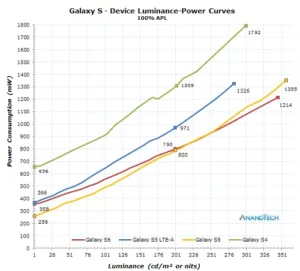Anandtech has posted an article analysing the varying power consumption levels of Samsung’s AMOLED displays, in the Galaxy S4, S5, S5 LTE-A and S6. A white image (forcing the OLED display to draw the most power) was used in the tests.
The older Galaxy S4 was, naturally, found to have the least efficient display. Most of this is due to the fact that Samsung introduced its Panel Self Refresh function on Galaxy S devices, starting in the S5. PSR reduces power consumption when showing static images, as frame buffer information is not re-sent to the display controller IC.
Due to component changes, each handset starts at minimum brightness with a slightly different power value. The S5 (258mW) had by far the best result in this metric, while the S4 (656mW) was the worst. Both the S5 LTE-A and S6 were slightly higher than the S5 (around 360mW) – likely due to their higher screen resolutions.
To compensate for the base power consumption, Anandtech normalised the power numbers for a 5.1″ display (results written as mW per cd/cm²). The results show a generational improvement. Again, the switch to 2560 x 1440 resolution appears to have affected the power consumption of the S5 LTE-A.
| AMOLED Screen Power Efficiency | ||||
|---|---|---|---|---|
| Device | Device Minimum Power (mW) | Device Maximum Power (Manual Br.) | Screen Luminance Power at 200 cd/m² (mW) | Normalised Power on 5.1″ Screen (mW/cd/cm²) |
| Galaxy S4 | 656 | 1,792 | 653 | 3.41 |
| Galaxy S5 | 258 | 1,355 | 532 | 2.66 |
| Galaxy S5 LTE-A | 366 | 1,326 | 605 | 3.02 |
| Galaxy S6 | 358 | 1,214 | 442 | 2.21 |
| Galaxy Note 4 | 452 | 1,690 | 665 | 2.69 |
| Source: Anandtech | ||||
The results demonstrate the best evidence of a new emitter and efficiency gains used in the Galaxy S6. Despite its higher power consumption at minimum brightness, the phone’s display catches and surpasses the S5 at higher brightness levels. An ‘apples-to-apples’ comparison is seen in the S5 LTE-A versus the S6; both devices are the same size and resolution. The S6’s display, however, is 36% more efficient.
The question is whether the newer AMOLED displays can match LCD displays in terms of efficiency at high APL values. Tests showed that the OLED displays are still about 33% less efficient than new LCD displays, when showing a white image. However, the white-screen consumption gap is closing. Anandtech also found that the S6’s display is more efficient than LCD devices at around 85% greyscale; even slightly-grey or -black content starts to shift the scales back in favour of AMOLED.
Report author Andrei Frumusanu estimates that Samsung still needs to improve efficiency by 15% – 20% before its AMOLED screens can compete with LCD devices, in even the worst-case scenarios. However, this seems to be an achievable goal for next year.

